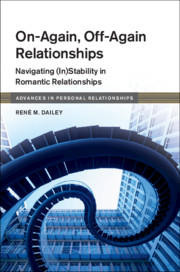Book contents
- On-Again, Off-Again Relationships
- Advances in Personal Relationships
- On-Again, Off-Again Relationships
- Copyright page
- Dedication
- Contents
- Figures
- Tables
- Acknowledgments
- Introduction
- 1 Description and Prevalence of On-Again/Off-Again Relationships
- 2 Differences from Non-Cyclical Relationships
- 3 Explaining On-Again/Off-Again Relationships
- 4 Types and Trajectories of On-Again/Off-Again Relationships
- 5 Breakups, Renewals, and In-Between
- 6 Conceptualizing (In)Stability
- 7 Practical Applications
- 8 Research Agenda
- Epilogue
- Appendix Description of Samples
- Notes
- References
- Index
3 - Explaining On-Again/Off-Again Relationships
Published online by Cambridge University Press: 02 December 2019
- On-Again, Off-Again Relationships
- Advances in Personal Relationships
- On-Again, Off-Again Relationships
- Copyright page
- Dedication
- Contents
- Figures
- Tables
- Acknowledgments
- Introduction
- 1 Description and Prevalence of On-Again/Off-Again Relationships
- 2 Differences from Non-Cyclical Relationships
- 3 Explaining On-Again/Off-Again Relationships
- 4 Types and Trajectories of On-Again/Off-Again Relationships
- 5 Breakups, Renewals, and In-Between
- 6 Conceptualizing (In)Stability
- 7 Practical Applications
- 8 Research Agenda
- Epilogue
- Appendix Description of Samples
- Notes
- References
- Index
Summary
Various theories have been used to explain the dynamics of on-off relationships. Despite individual differences being a potential explanation for the occurrence of cycling, research on personality (e.g., the Big 5), attachment dimensions, and self-esteem show few differences have emerged between on-off and non-cyclical partners. In contrast, social exchange theories such as interdependence theory and the investment model appear to operate similarly for on-off and non-cyclical relationships, but perceptions of alternatives might be playing a stronger role in on-off relationships. For example, on-off partners view their current partners and potential alternatives as offering similar outcomes, which could facilitate dissolution to explore alternatives. In general then, although on-off partners consistently report lower relational quality, certain relationship theories can be employed to understand the functioning of these relationships. However, because models or theories of relationship progression do not explicitly incorporate the potential of cycling, theories specific to the unique nature of on-off relationships (e.g., multiple relational transitions) are needed to understand reconciliations and their effects. For example, inertia theory has explored how on-off partners make less conscious decisions regarding their relational transitions. Using theories such as this with longitudinal data offer greater insights on the development and perpetuation of cycling.
- Type
- Chapter
- Information
- On-Again, Off-Again RelationshipsNavigating (In)Stability in Romantic Relationships, pp. 52 - 73Publisher: Cambridge University PressPrint publication year: 2019



